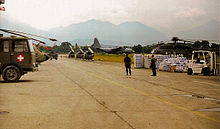Task Force ALBA
Task Force ALBA was a humanitarian operation by the Swiss Air Force in Albania as part of a UNHCR mission in 1999. It was the Air Force’s first long humanitarian mission abroad and the first by Swiss Army helicopters in the outskirts of a war zone.
initial situation
Albania: main operating sites of the task force |
As early as 1998, due to the smoldering conflict in Kosovo, the number of refugees from the area applying for asylum in Switzerland rose so much that the civilian aid capacities in Switzerland reached their limits. As a result, the Federal Council decided at the end of 1998 to deploy the army to provide support and to get involved directly in the crisis area in order to prevent further swelling.
In March 1999, the governments of Albania and Macedonia requested international humanitarian intervention after large streams of Kosovar Albanian civilians had entered these countries and NATO air strikes on Yugoslavia began. On April 1, 1999, shortly before Easter, the Federal Council ordered military aid to support the primarily helping Swiss Corps for Humanitarian Aid (SH) and the UNHCR .
Course of the operation
As part of this task force , the missions were carried out by pilots from the Air Force Surveillance Squadron (UeG) with three transport helicopters of the type AS 532 Cougar ("Super Puma"; serial numbers T-315, T-322 and T-312). Walter Knutti , who later became the Swiss air force commander, was in charge .
First, on Good Friday, various deployment plans were drawn up in the helicopter base of the Swiss Air Force at the Alpnach military airfield . On Easter Sunday, a preliminary exploration team flew to Albania. On Easter Monday the helicopters were made ready and loaded with the necessary equipment. On the Tuesday after Easter (April 6th) the first helicopter flew over Florence and Brindisi to Tirana . The next two Super Puma had to fly over southern Italy and Greece , as NATO had set up a no-fly zone over the Adriatic . The camp was set up at Rinas Airport (Tirana) , which was then taken over by the American army .
Additional personnel from the Federal Office for Operations in the Air Force (BABLW) and the Fortress Guard Corps (FWK) were flown in with Falcon and Learjets . The material arrived in Albania by truck on Friday evening. From the next day, the daily replenishment and personnel exchange was taken over by a rented transport aircraft of the Spanish Air Force (type CASA CN-235 ). The construction of the infrastructure of the camp at the airport initially encountered various problems such as swampy terrain and non-existent sanitary facilities, which were overcome over time. On April 9th there was full operational readiness.
The primary purpose of the operation was to supply the refugee camps around the northern Albanian town of Kukës near the border with Kosovo. The region in the mountainous northeast of Albania was isolated and very difficult to reach by road. Around 50 volunteer members of the army were involved on site, a total of almost 150 people. In 725 missions and almost 800 flight hours (around 25% of the usual annual budget), 878 tons of material (mainly food) and 5200 passengers were transported and 350 medical evacuations of the seriously injured were carried out.
Conclusion
The Swiss Air Force had to deal with new types of difficulties in the ALBA task force, which brought new experience. In principle, the use of the neutral country in the context of NATO operations was problematic, i.e. the risk of possible involvement in conflicts and unilateral statements ( interoperability ). Other problem areas were legal issues (legal status, carrying weapons), the lack of concepts (e.g. for operations, logistics , support), insufficient transport capacities over long distances, insufficient human resources in the professional organization of the Air Force, and political resistance against the possible use of militia personnel and crisis management in rapidly changing framework conditions.
The experiences from the ALBA Task Force were evaluated for the subsequent Swisscoy deployment as part of the multinational KFOR operation in Kosovo.
Web links
- Tame Pumas over Albania , report in Swissaviation , June 4, 1999
- Federal Aid - The Swiss Confederation helped displaced people in Albania with great commitment , report in newsletter Albania , July 25, 1999



